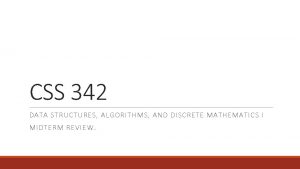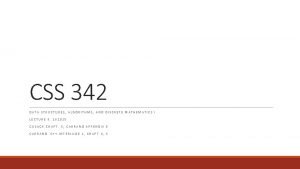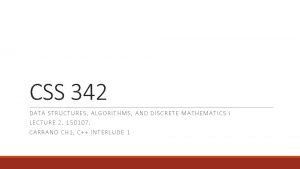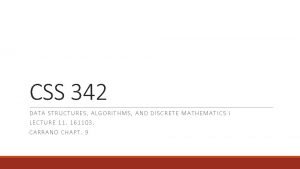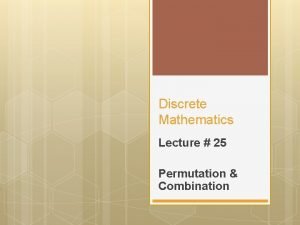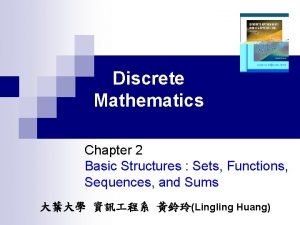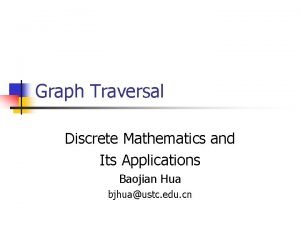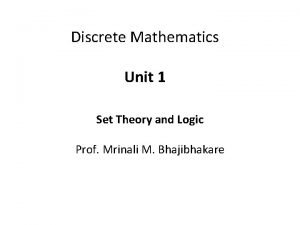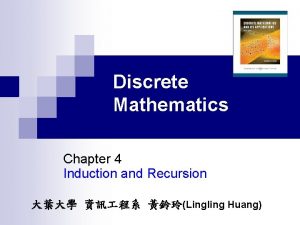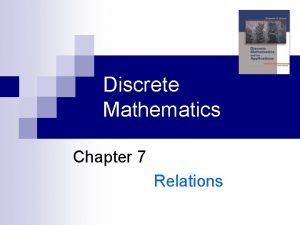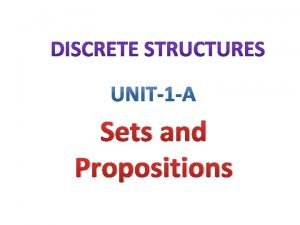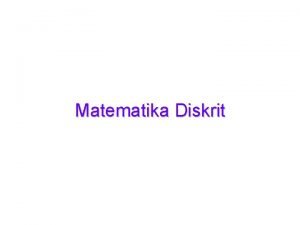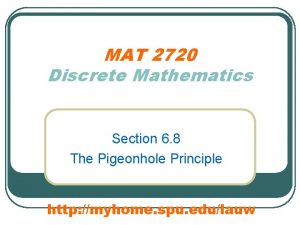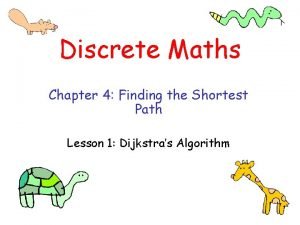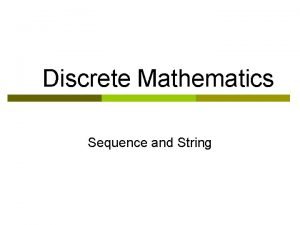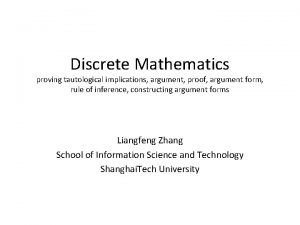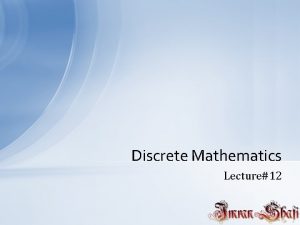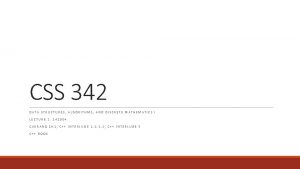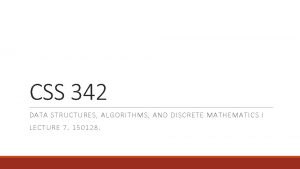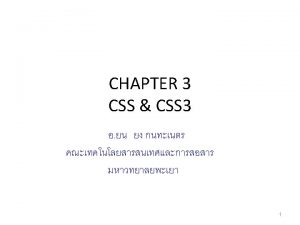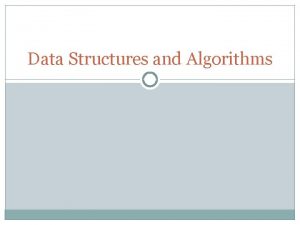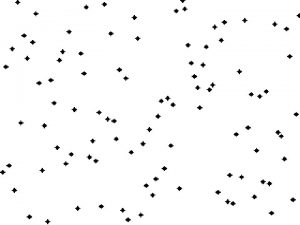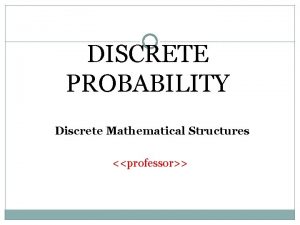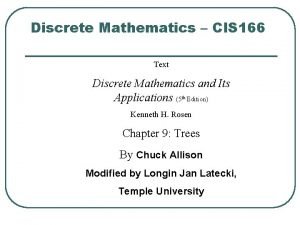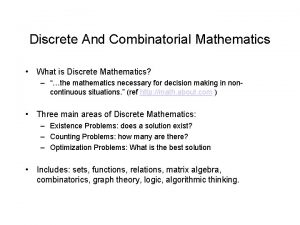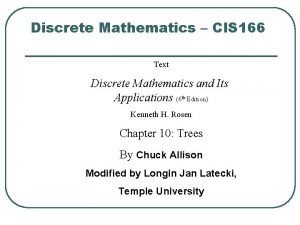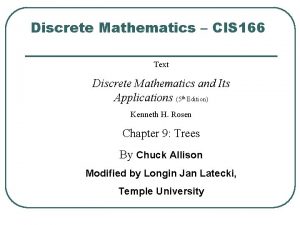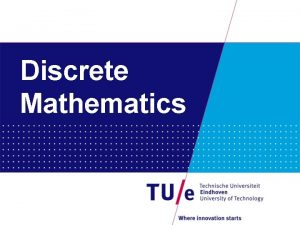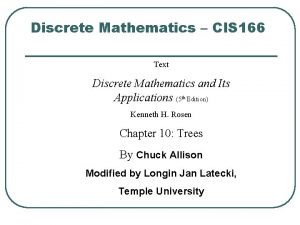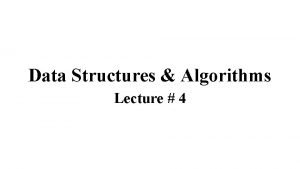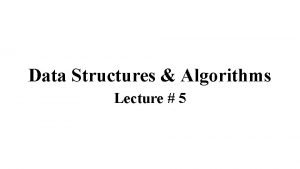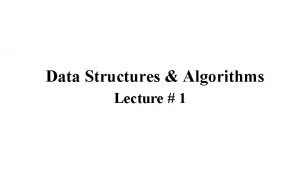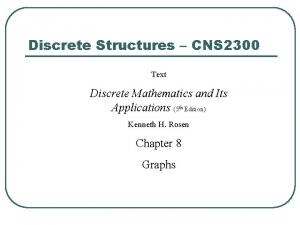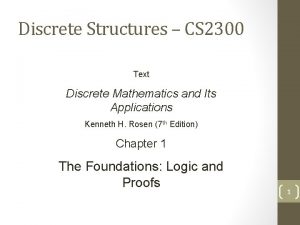CSS 342 DATA STRUCTURES ALGORITHMS AND DISCRETE MATHEMATICS








![8 Queens: Pseudo-code bool add. Queen(bool t[SIZE], int col) { if (col >= SIZE) 8 Queens: Pseudo-code bool add. Queen(bool t[SIZE], int col) { if (col >= SIZE)](https://slidetodoc.com/presentation_image_h2/8bd56e4a84eab52bc92ac26c6024653c/image-9.jpg)






















- Slides: 31

CSS 342 DATA STRUCTURES, ALGORITHMS, AND DISCRETE MATHEMATICS I LECTURE 8. 161025 CUSACK CHAPT. 8, CARRANO APPENDIX E CARRANO C++ INTERLUDE 2, CHAPT 4, 6

Agenda • Finish Recursion • Dynamic Memory • Lab 3 • Induction • Hand back quiz

Typical types of recursion • Returns Value (n!, …) • Performs an action (adds to a string, … • Divides in half recursively (binary search, … • Tail Recursion • Backtracking (will introduce in future slides)

Costs of Recursion • Main cost of recursion is memory usage on stack • Stack v. Heap • • Compiler chooses where to allocate space from. Not always clear and compiler can make optimizations. Stack is per thread and limited. When space runs out: Stack Overflow. Function calls place locals, call parameters on stack Heap gets calls to malloc/free; new/delete generally on heap

Review: The Box Trace. Memory usage on thread stack! FIGURE 2 -5 BOX TRACE OF FACT(3) … CONTINUED Data Structures and Problem Solving with C++: Walls and Mirrors, Carrano and Henry, © 2013

Backtracking as a problem solving technique While (solution not complete) { if (in good state) “move forward guessing at solution” else “backtrack to last good state” } Often used in combination with Recursion

Backtrack: 8 queens problem Place 8 queens on a 8 * 8 chessboard so that no queen can attack any other queen. 7

Place one queen in one column at a time. Backtrack when problems occur. *from Carranno
![8 Queens Pseudocode bool add Queenbool tSIZE int col if col SIZE 8 Queens: Pseudo-code bool add. Queen(bool t[SIZE], int col) { if (col >= SIZE)](https://slidetodoc.com/presentation_image_h2/8bd56e4a84eab52bc92ac26c6024653c/image-9.jpg)
8 Queens: Pseudo-code bool add. Queen(bool t[SIZE], int col) { if (col >= SIZE) { return true; } for (int row = 0; row < SIZE; row ++) { if (safe. Location(t, row, col)) { t[row][col] = true; if (add. Queen(t, col + 1)) { return true; } else { t[row][col] = false; } } } return false; } // place a new queen in the row // all the following cols were filled // A wrong position. Try the next row // all rows examined, but no candidates

Recursive Applications Discrete Mathematics (Combinatorics, Puzzles, Coding Theory) ◦ Tower of Hanoi and Gray Code Divide and Conquer ◦ Mergesort, Convex Hall, and Fast Fourier Transform Backtrack ◦ 8 Queens, Maze and Classic Chess Program Fractal Figures ◦ Koch, Sierpinski Allowhead, Gosper, Hilbert, and Dragon curves

Recursion w/Alice https: //www. youtube. com/watch? v=-3 Mcu 7 o 1 YSg (1: 32)

Dynamic Memory

Dynamic Allocation 1. Pointer declaration int *p, *q; 2. Dynamic allocation p = new int; q = new int; 3. Deallocation delete p; p = NULL; 4. 1 Memory leak ? p q = new int; 2 ? p p ? ? q NULL 3 q 4 NULL p ? q Leak! ? q ?

Bird* Create. Flock(int size, string name); int main() { int size; string b. Name; Bird *bird. Flock; cout << "Create a flock. cin >> b. Name; cout << "Input size: "; cin >> size; Input the name: "; while (true) { bird. Flock = Create. Flock(size, b. Name); // add the following line to get rid of leak // delete[] bird. Flock; } return 0; } Bird* Create. Flock(int num, string name) { Bird *p. Bird; p. Bird = new Bird[num]; for (int i = 0; i < num; i++) { p. Bird[i]. set. Name(name); p. Bird[i]. set. ID(i); } return p. Bird; }

Computer Scientist of the week Charles Babbage • Mathematician, Philosopher, Mechanical Engineer • Invented the first mechanical computer • Difference Engine: Computed values of polynomial functions • If completed at the time would have had 25000 parts • Finished in 1991 • Analytical Engine • Punch card based • Branching and looping supported • Currently being build: 7 Hz and 675 Bytes

Stack Bird* Create. Flock(int num, string name) { Bird *p. Bird; p. Bird = new Bird[num]; for (int i = 0; i < num; i++) { p. Bird[i]. set. Name(name); p. Bird[i]. set. ID(i); } return p. Bird; } heap Global/Static Data Code/Text

Program 3 REVIEW

Quiz MEDIAN: 74

Grades Review Labs (5): Exams/Quizzes: http: //www. uwb. edu/registration/policies/grading-ug 35% 65%

Lab 1 • Rubric posted on Canvas • Did not take off points on style but comments show what was not followed. Will deduct points next time SCORE GRADE 86 -100 3. 5 -4 70 -85 2. 5 -3. 4 57 -69 2. 0 -2. 4 <57 <2. 0

Class Bell

In Class Code 1) Write a function which reverses the elements in an array. Input is the array and size of the array. 2) Do this in a way that does not use [ ] anywhere

Induction 1; N -> N+1

Induction Axiom: The principle of mathematical induction A property P(n) that involves an integer n is true for all n ≥ 0 if the following are true: 1. P(0) is true. 2. If P(k) is true for any k ≥ 0, then P(k+1) is true.

Some history* *from our good friends at Wickapedia


Proof by Induction for n x Write a recursive function which calculates xn Prove the correctness of the recursive solution using induction int pow(int x, int n) { if (n == 0) return 1; else return x * pow(x, n-1); }

Proof by Induction for 1. Basis: 2. Inductive hypothesis: 3. 4. n x When n = 0, pow(x, 0) = 1. x 0 = 1. The recursive function is correct. When n = k, assume that pow(x, k) is correct, i. e. , xk. Inductive step: Show the pow(x, k+1) is correct. pow(x, k+1) = x * pow(x, k) By the inductive hypothesis, pow(x, k) returns the value xk. Thus, pow(x, k+1) = x * xk = xk+1 If pow(x, k) is correct, pow(x, k+1) is correct. Therefore, by the principle of mathematical induction, pow(x, n) is correct for any n ≥ 1.

Prove: a+ar 1+ar 2+ar 3+ … +arn =a(rn+1 – 1)/(r-1)

Strong Form of Mathematical Induction A property P(n) that involves an integer n is true for all n ≥ 0 if the following are true: 1. 2. P(0) is true. If P(0), P(1), …, P(k) are true for any k ≥ 0, then P(k+1) is true. Difference from ordinary form of mathematical induction: P(k+1) is factorized in a combination of two or more of P(0) through to P(k). Proof by strong form of mathematical induction 1. 2. I. II. Base case or (basis): prove P(0) is true. Inductive step: Inductive hypothesis: Assume P(1), P(2), . . , P(k) is true for any k ≥ 0 Inductive conclusion: Prove P(k+1) is true.

Prove using induction: Every Integer > 1 Can Be Written as a Product of Prime Integers 1. Basis: n = 2. 2 is a prime number itself, and thus can be written as a product of prime integers. The proposition is true. 2. Strong Inductive hypothesis: Assume that the proposition is true for each of the integers 2, 3, … k 3. Inductive step: Show the proposition is true for k + 1. If k + 1 is a prime number, there is nothing more to show. If k + 1 is NOT a prime number, k + 1 is divisible and can be written k + 1= x * y where 1 < x < k + 1 and 1 < y < k + 1 Notice that x and y can be written as a product of prime integers by inductive hypothesis. If k is a product of prime numbers, k+1 is a product of prime numbers. Therefore, by the principle of mathematical induction, the proposition is true when n ≥ 1.
 Css 342
Css 342 Css342 pdf
Css342 pdf Css 342
Css 342 Algo tr
Algo tr Ajit diwan iit bombay
Ajit diwan iit bombay Princeton data structures and algorithms
Princeton data structures and algorithms Data structures and algorithms tutorial
Data structures and algorithms tutorial Information retrieval data structures and algorithms
Information retrieval data structures and algorithms Data structures and algorithms bits pilani
Data structures and algorithms bits pilani Data structures and algorithms iit bombay
Data structures and algorithms iit bombay Data structures and algorithms
Data structures and algorithms Data structures and algorithms
Data structures and algorithms Waterloo data structures and algorithms
Waterloo data structures and algorithms Signature file structure in information retrieval system
Signature file structure in information retrieval system Data structures and algorithms
Data structures and algorithms Algorithms + data structures = programs
Algorithms + data structures = programs Permutation and combination in discrete mathematics
Permutation and combination in discrete mathematics Sequence discrete math
Sequence discrete math Graph traversal in discrete mathematics
Graph traversal in discrete mathematics Discrete math set theory
Discrete math set theory Induction and recursion discrete mathematics
Induction and recursion discrete mathematics Antisymmetric relation
Antisymmetric relation Sets and propositions in discrete mathematics
Sets and propositions in discrete mathematics Kenneth rosen discrete mathematics pdf
Kenneth rosen discrete mathematics pdf Pigeonhole principle in discrete mathematics
Pigeonhole principle in discrete mathematics What is tautology in math
What is tautology in math Kesetaraan logis
Kesetaraan logis Shortest path problem in discrete mathematics
Shortest path problem in discrete mathematics Sequence discrete math
Sequence discrete math Tautological implications
Tautological implications Binary relation in discrete mathematics
Binary relation in discrete mathematics Applications of propositional logic
Applications of propositional logic
